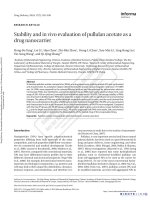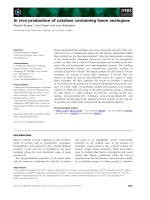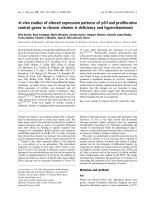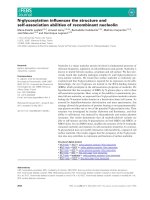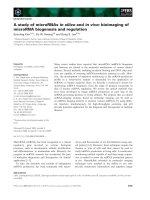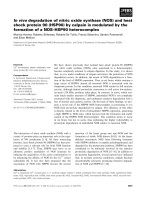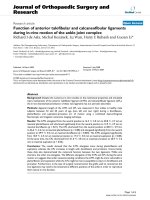In vitro and in vivo characterisation of recombinant lactobacilli expressing house dust mite allergen
Bạn đang xem bản rút gọn của tài liệu. Xem và tải ngay bản đầy đủ của tài liệu tại đây (1.92 MB, 193 trang )
IN VITRO AND IN VIVO CHARACTERIZATION OF
RECOMBINANT LACTOBACILLI EXPRESSING
HOUSE DUST MITE ALLERGEN
LIEW LEE MEI
NATIONAL UNIVERSITY OF SINGAPORE
2009
IN VITRO AND IN VIVO CHARACTERIZATION OF RECOMBINANT
LACTOBACILLI EXPRESSING HOUSE DUST MITE ALLERGEN
LIEW LEE MEI
2009
IN VITRO AND IN VIVO CHARACTERIZATION OF
RECOMBINANT LACTOBACILLI EXPRESSING
HOUSE DUST MITE ALLERGEN
LIEW LEE MEI
(B.Sc., the National University of Singapore, Singapore)
A THESIS SUBMITTED
FOR THE DEGREE OF MASTER OF SCIENCE
DEPARTMENT OF PAEDIATRICS
NATIONAL UNIVERSITY OF SINGAPORE
2009
ACKNOWLEDGEMENT
First and foremost, I would like to express the depth of my gratitude to my
supervisor, Professor Chua Kaw Yan, for providing invaluable knowledge,
constructive ideas and constant support during my course of research study.
I would like to give a special thanks to my fellow seniors Dr Huang Chiung-Hui,
Dr. Seow See Voon and Dr. Kuo I-Chun who have been providing continual
guidance and ideas in this project. My gratitude continues to my fellow labmates
especially Mdm Wen Hongmei, Miss Ding Ying and Mr. Andy Soh Gim Hooi for
providing me technical assistance.
I also wish to thank Dr. Lars Axelsson for providing Lactococcus lactis subspecies
cremoris MG1363, Lactobacillus plantarum strain NC8 and pSIP412 expression
vector as well as his excellent technical advice in this work.
Besides, I am grateful to Dr. Lee Sanghoon, Miss Jean Xie and Miss Kelly Ong
who have supported and given me time to complete my master thesis.
Last but not least, I sincerely thank my family for their love, understanding and
great support throughout these years. To all my dear friends, I truly thank you for
the sharing, joys and company.
i
TABLE OF CONTENT
ACKNOWLEDGEMENT
i
TABLE OF CONTENTS
ii
SUMMARY
viii
LIST OF FIGURES
xi
LIST OF TABLES
xiv
LIST OF ABSTRACTS
xv
LIST OF PUBLICATION
xvi
ABBREVIATIONS
xvii
Chapter 1: Introduction
1-32
1.1 House dust mite allergy-associated allergic diseases
1
1.1.1
Blomia tropicalis mite allergens
4
1.1.2
Immunological mechanisms
6
1.1.3
Current preventive measures and therapeutic approaches
9
1.2 The history and definition of probiotics
13
1.2.1
The genus Lactobacillus
16
1.2.2
Scientific classification of Lactobacillus
16
1.2.3
Taxonomy of Lactobacillus genus
17
1.2.4
Epidemiological studies on probiotics and allergy
17
1.2.5
Clinical studies of probiotics in the management of
18
allergic disorders
1.2.5.1 Probiotic prevention for atopic eczema
19
1.2.5.2 Probiotic treatment for atopic eczema
20
ii
1.2.5.3 Probiotic treatment for allergic rhinitis and asthma
1.3 Oral delivery of vaccines
1.3.1
Unique features of lactobacilli as antigen-based oral
21
22
23
delivery vehicles
1.3.2
Mechanisms of lactobacilli as immunomodulator
25
1.3.3
Strain selection
27
1.3.3.1 Lactobacillus plantarum
27
1.3.3.2 Lactobacillus rhamnosus GG
28
1.4 The rationale of the study
30
1.5 The specific aim and experimental strategies of the study
32
Chapter 2: Materials and Methods
33-59
2.1 Materials
33
2.1.1
Yeast and bacterial strains
33
2.1.2
Yeast and bacterial culture media
35
2.1.3
Reagents for protein purification, identification and
35
analysis
2.1.4
Plasmid and reagents for molecular cloning
36
2.1.5
Mice
36
2.1.6
Inducing peptide for protein induction
38
2.1.7
Reagents for mice immunization
38
2.1.8
Reagents for cell culture
38
2.1.9
Antibodies and recombinant cytokines
39
iii
2.2 Methods
40
2.2.1
Purification of recombinant Blo t 5
40
2.2.2
Gel electrophoresis
41
2.2.3
Western blotting
42
2.2.4
Bacterial growth conditions
42
2.2.5
The construction of pSIP412-Bt5 expression vector
43
2.2.6
Electrotransformation of Lactococcus lactis
45
2.2.7
Plasmid extraction and DNA sequencing
47
2.2.8
Electrotransformation of Lactobacillus strains
47
2.2.9
The induction and quantification of Blo t 5 expression in
48
recombinant lactobacilli
2.2.10 The Blo t 5 stability in recombinant LGG
49
2.2.11
49
Preparation of live and heat-killed lactobacilli
2.2.12 Bone
marrow-derived
dendritic
cells and bacteria
50
coculture
2.2.13 Surface marker staining of pulsed BMDCs
51
2.2.14 Co-culture of lactobacilli-pulsed BMDCs and Blo t
52
5-specific T cells
2.2.15 Flt3-derived dendritic cells
52
2.2.16 Animal immunization protocols
53
2.2.16.1 Experiment I: In vivo immunogenicity study
53
2.2.16.2 Experiment II: Prophylactic model
53
2.2.16.3 Experiment III: Allergic airway inflammation model
54
2.2.17 Sera collection
54
2.2.18 BALF collection and cytospin preparation
54
2.2.19 Splenic and lymph nodes cell cultures
55
2.2.20 Preparation of antigen presenting cells
56
2.2.21 Detection of Blo t 5-specific IgE and IgG1
56
2.2.22 Mouse IgG2c quantitative ELISA
57
iv
2.2.23 Cytokine ELISA
58
2.2.24 Statistical analysis
59
Chapter 3: The
in
vitro
characterisation
of
recombinant
60-96
lactobacilli expressing Blo t 5
3.1 Introduction
60
3.2 Results
63
3.2.1
Purification of recombinant Blo t 5 from Pichia pastoris
63
culture media
3.2.2
Construction and transformation of pSIP412-Bt5 into
66
lactobacilli.
3.2.3
Expression kinetics of Blo t 5 in recombinant lactobacilli
69
3.2.4
Quantification of Blo t 5 in recombinant lactobacilli
72
3.2.5
The immunomodulatory effect of recombinant lactobacilli
77
on murine bone marrow-derived dendritic cells (BMDCs)
3.2.5.1 The expression profiles of surface markers on
77
BMDCs
3.2.5.2 The cytokine production by BMDCs
3.2.6
The effect of recombinant lactobacilli on cytokine
78
81
production by murine Flt3-derived dendritic cells
3.2.7
Induction of antigen-specific T cell activation by
84
recombinant lactobacilli pulsed-murine BMDCs
3.2.7.1 The proliferation of Blo t 5-specific T cells
84
3.2.7.1 The cytokine production by Blo t 5-specific T cells
85
3.3 Discussion
88
v
Chapter 4: The in vivo evaluation of the recombinant lactobacilli
97-133
in mouse allergy models
4.1 Introduction
97
4.2 Results
100
The immunogenicity of recombinant lactobacilli in vivo
100
4.2.1.1 The immunogenicity of recombinant Lactobacillus
102
4.2.1
plantarum NC8
107
4.2.1.2 The immunogenicity of recombinant LGG
4.2.2
The prophylactic anti-allergy effects of recombinant
111
lactobacilli in a mouse allergy model
4.2.2.1 The prophylactic effects of recombinant Lactobacillus
113
plantarum NC8
118
4.2.2.2 The prophylactic effects of recombinant LGG
4.2.3
The evaluation of the anti-inflammatory effects of
recombinant
lactobacilli
in
an
allergic
123
airway
inflammation mouse model
4.3 Discussions
127
Chapter 5: Conclusion and Future Prospects
134-138
REFERENCES
139-161
vi
APPENDICES
162-171
1. The cDNA sequence of Blomia tropicalis group 5 allergen
162
2. The NMR Solution Structure of Blo t 5.
163
3. Culture media for Lactococcus lactis MG 1363
165
4. Culture media for Lactobacillus strains
166
5. DNA sequence of the pSIP412 expression vector
167
6. Skeletons of mouse right hind limb
171
vii
SUMMARY
The prevalence of allergic asthma, allergic rhinitis and atopic dermatitis has been
increasing worldwide in recent decades. The dust mite Blomia tropicalis is one of the
main triggering factors for allergic diseases. This mite species is affecting
approximately one billion people in the tropics, subtropics and certain temperate
regions. Allergen-specific immunotherapy is currently the only means to alter the
underlying mechanisms that lead to cure the allergic diseases. Several preclinical
studies and clinical trials have suggested a possible role of lactobacilli in the
prevention and treatment of allergic diseases. Lactobacilli are generally regarded as
safe for oral consumption. They possess distinct adjuvant properties and exert
differential immunomodulatory effects on dendritic cells (DCs). The use of
lactobacilli as live vectors for oral delivery is a desirable strategy for the development
of oral vaccine for allergy.
The aim of this study is to evaluate the immunomodulatory effects of Lactobacillus
plantarum NC8 and Lactobacillus rhamnosus GG on DCs in vitro and in murine
allergy models in vivo. The major allergen from Blomia tropicalis, Blo t 5, was
expressed in both Lactobacillus strains intracellularly using the pSIP412 expression
vector. Both recombinant Lactobacillus plantarum NC8 (rLp) and recombinant
Lactobacillus rhamnosus GG (rLGG) could induce the maturation of bone marrowderived dendritic cells (BMDCs) as measured by the upregulation of surface markers
viii
and cytokine production. Furthermore, recombinant lactobacilli-pulsed BMDCs
effectively activated a Blo t 5-specific T cell line. However, both recombinant
lactobacilli exhibited differential modulatory effects on murine DCs as reflected by
their differential cytokine production profiles.
The in vivo evaluation focused on the immunogenicity of recombinant lactobacilli
and their protective effects against allergen-specific Th2 immune responses. Both
recombinant lactobacilli-fed naive mice could elicit Blo t 5-specific B and T cell
responses. In the prophylactic model, mice pre-fed with either recombinant
Lactobacillus strain were protected against Blo t 5 sensitisation by intraperitoneal
injection with Blo t 5 in alum as shown by the attenuation of Blo t 5-specific IgE, the
concomitant enhancement of protective Blo t 5-specific IgG2c, and the suppression of
Th2 cytokines production by Blo t 5-stimulated splenocytes and cells from mesenteric
lymph nodes (MLN). In the therapeutic model, mice were adoptively transferred with
Blo t 5-specific Th2 cell line and fed with recombinant lactobacilli followed by the
intranasal challenge with Blo t 5. Recombinant Lactobacillus rhamnosus GG-fed
mice showed attenuated allergic airway inflammation as manifested by the reduction
of the signature cell type for allergic inflammation, eosinophils, in the
bronchoalveolar lavage fluids.
In summary, recombinant lactobacilli expressing respectable levels of Blo t 5 protein
have been generated and comparatively evaluated by in vitro and in vivo studies. Both
recombinant lactobacilli were effective in the prevention of allergen sensitisation
ix
despite their respective differential immunomodulatory properties in vitro.
Lactobacillus rhamnosus GG was more effective than the recombinant Lactobacillus
plantarum NC8 in the suppression of established airway inflammation. Further
studies are required to address the underlying mechanisms and the clinical application
in controlling the allergic diseases.
(489 words)
x
LIST OF FIGURES
Figure No.
Figure 1.1
Title
Frontal view of Blomia tropicalis enlarged 200 times
Page
5
Figure 1.2
Allergic Mechanisms
8
Figure 2.1
Schematic diagram of the pSIP412-Bt5 expression vector
37
Figure 2.2
The schematic representation of the construction of
pSIP412-Bt5 expression vector
44
Figure 2.3
The schematic diagram showing the strategy for the generation
of recombinant lactobacilli carrying pSIP412-Bt5
46
Figure 3.1
Characterization of recombinant Blo t 5 produced from Pichia
pastoris
65
Figure 3.2
Analysis of pSIP412-Bt5 construct
68
Figure 3.3
Kinetics of Blo t 5 expression in recombinant lactobacilli
70
Figure 3.4
Western blot analysis of Blo t 5 expressed in recombinant 71
lactobacilli
Figure 3.5
The quantification of Blo t 5 expression in recombinant 74
lactobacilli
Figure 3.6
The stability of Blo t 5 produced in Lactobacillus rhamnosus 76
GG
Figure 3.7
The phenotypes and maturation status of murine bone-marrow 79
derived dendritic cells (BMDCs) co-cultured with recombinant
lactobacilli
Figure 3.8
The cytokine production of murine bone-marrow derived 80
dendritic cells (BMDCs) co-cultured with recombinant
lactobacilli
Figure 3.9
The cytokine production of murine Flt3-derived dendritic cells 83
co-cultured with recombinant lactobacilli
xi
Figure 3.10
Recombinant lactobacilli-pulsed bone-marrow derived dendritic 86
cells (BMDCs) induced the proliferation of a Blo t 5-specific T
cells
Figure 3.11
Recombinant lactobacilli-pulsed bone-marrow derived dendritic 87
cells (BMDCs) induced the cytokine production of Blo t
5-specific T cells
Figure 4.1
The experimental protocol I for the evaluation of in vivo 101
immunogenicity of the Blo t 5 expressed in recombinant
lactobacilli
Figure 4.2
Oral feeding of recombinant Lactobacillus plantarum NC8 104
induced the production of Blo t 5-specific immunoglobulins in
mice
Figure 4.3
Oral feeding of recombinant Lactobacillus plantarum NC8 105
enhanced the production of TGF-β in mesenteric lymph node
cultures
Figure 4.4
Oral feeding of recombinant Lactobacillus plantarum NC8 106
enhanced the production of cytokines in splenic cultures
Figure 4.5
Oral feeding of recombinant Lactobacillus rhamnosus GG 108
induced the Blo t 5-specific IgG2c production in mice
Figure 4.6
Oral feeding of recombinant Lactobacillus rhamnosus GG 109
enhanced the production of IFN-γ and TGF-β in mesenteric
lymph node cultures
Figure 4.7
Oral feeding of recombinant Lactobacillus rhamnosus GG 110
enhanced the production of cytokines in splenic culture
Figure 4.8
The experimental protocol II for the study of prophylactic 112
effects of recombinant lactobacilli in the allergic murine model
Figure 4.9
Oral feeding of recombinant Lactobacillus plantarum NC8 115
suppressed the production of Blo t 5-specific IgE and induced
the production of Blo t 5-specific IgG1 and IgG2c in mice
Figure 4.10
The cytokine profile of mesenteric lymph node cultures from 116
mice fed with recombinant Lactobacillus plantarum NC8
xii
Figure 4.11
The cytokine profile of splenocyte cultures from mice fed with 117
recombinant Lactobacillus plantarum NC8
Figure 4.12
Oral feeding of recombinant Lactobacillus rhamnosus GG 120
suppressed the production of Blo t 5-specific IgE and induced
the production of Blo t 5-specific IgG1 and IgG2c in mice
Figure 4.13
Oral feeding of recombinant Lactobacillus rhamnosus GG 121
suppressed the IL-13 production in mesenteric lymph node
cultures
Figure 4.14
The cytokine profile of splenocyte cultures from mice fed with 122
recombinant Lactobacillus rhamnosus GG
Figure 4.15
The experimental protocol III for the study of protective effects
of recombinant lactobacilli in an allergic airway inflammation 125
model
Figure 4.16
Oral feeding of recombinant Lactobacillus rhamnosus GG but 126
not recombinant Lactobacillus plantarum NC8 reduced the
allergic airway inflammation in lungs
xiii
LIST OF TABLES
Table No.
Table 2.1
Title
Page
The characteristics of plasmid and bacterial strains used in 34
this study
Table 3.1
The amount of Blo t 5 expressed in recombinant 75
Lactobacillus strains.
xiv
LIST OF ABSTRACTS (DERIVED FROM THIS THESIS)
Conference Abstracts:
Poster Presentations:
1. Lee Mei Liew, Chiung-Hui Huang, See Voon Seow, Ying Ding, Hongmei
Wen, I-Chun Kuo, Kaw Yan Chua. 2007. Immunological Characterization
of Recombinant Lactobacillus plantarum Expressing Major Mite Allergen
Blo t 5. The XX World Allergy Congress 2007 (1-6 December 2007),
Bangkok, Thailand.
2. LM Liew, CH Huang, SV Seow, Y Ding, HM Wen, KY Chua. Suppression
of allergen-specific IgE production by oral administration of recombinant
Lactobacillus plantarum in mice. The VII NHG Annual Scientific Congress
2008 (7-8 November 2008), Singapore.
3. LM Liew, CH Huang, SV Seow, Y Ding, HM Wen, KY Chua. Suppression
of allergen-specific IgE production by oral administration of recombinant
Lactobacillus plantarum in mice. Joint Singapore Peadistrics Congress &
Asia Pacific Association of Allergology, Respirology & Immunology
(APAPPARI) Meeting 2008 (3-5 October 2008), Singapore.
4. LIEW Lee Mei, HUANG Chuing-Hui, WEN Hongmei, KUO I-Chun,
SOH Gim Hooi, CHUA Kaw Yan. Recombinant Lactobacillus as an oral
vaccine for allergic asthma. BioMedical Asia 2009 (16-19 March 2009),
Singapore.
xv
LIST OF PUBLICATION
Publication derived from the thesis:
1. Liew LM, Huang CH, Seow SV, Ding Y, Wen HM, Kuo IC, Chua KY. Suppression
of allergen-specific Th2 immune responses by oral administration of recombinant
Lactobacillus strain in mice. (Manuscript in preparation).
Publication in the related fields:
1.
Tan LK, Huang CH, Kuo IC, Liew LM, Chua KY. Intramuscular immunization
with DNA construct containing Der p 2 and signal peptide sequences primed
strong IgE production. Vaccine. 2006. 24:5762-71.
2.
Huang CH, Liew LM, Mah KW, Kuo IC, Lee BW, Chua KY. Characterization of
glutathione S-transferase from dust mite, Der p 8 and its immunoglobulin E
cross-reactivity with cockroach glutathione S-transferase. Clin Exp Allergy. 2006.
36:369-76.
xvi
ABBREVIATION
3D
three-dimensional
aa
amino acid
Ag
antigen
alum
aluminum hydroxide
APC
antigen presenting cell
AU
arbitrary unit
BALF
bronchoalveolar lavage fluids
Blo t
Blomia tropicalis
BMDC
bone marrow-derived dendritic cell
bp
basepair
BSA
bovine serum albumin
CCL2
CC-chemokine ligand
CD
Cluster of differentiation
cDNA
complementary deoxyribonucleic acid
cfu
colony forming units
cpm
count per minute
CXCL
CXC-chemokine ligand
DC-SIGN
DC-specific
intercellular
adhesion
molecule
3-grabbing
non-integrin
Der f
Dermatophagoides farinae
Der p
Dermatophagoides pteronyssinus
DTT
dithiothreitol
E. coli
Escherichia coli
ELISA
enzyme-Linked immunosorbent assay
eos
eosinophils
xvii
Eur m
Euroglyphus maynei
GI
gastrointestinal
GM-CSF
Granulocyte macrophage-colony stimulating factor
GRAS
generally regarded as safe
GST
Glutathione S-transferase
HBSS
Hanks’ balanced salt solution
HDM
house dust mites
IFN
Interferon
Ig
immunoglobulin
i.n.
intranasal
i.p.
intraperitoneal
i.v.
intravenous
IL
Interleukin
ISS-ODN
immunostimulatory oligodeoxynucleotide
kDa
kilo Daltons
LAB
lactic acid bacteria
Ll
Lactococcus lactis subspecies cremoris MG1363
LPS
lipopolysaccharide
LTC4
leukotriene C4
lym
lymphocytes
mAb
monoclonal antibody
mac
macrophages
MHC
major histocompatibility complex
MLN
mesenteric lymph node
mono
monocytes
MW
molecular weight
neu
neutrophils
ND
Non-detectable
NICE
nisin-controlled expression
xviii
NMR
Nuclear Magnetic Resonance
OD
optical density
OVA
ovalbumin
PBS
phosphate buffered saline
PCR
polymerase chain reaction
pepN
aminopeptidase N
pI
isoelectric point
RBC
red blood cell
rBlo t 5
recombinant Blomia tropicalis group 5
rLGG
recombinant Lactobacillus rhamnosus GG
rLp
recombinant Lactobacillus plantarum NC8
rpm
rotation per minute
SCIT
subcutaneous injection
SCORAD
scoring atopic dermatitis
SEM
standard Error of Mean
SIT
allergen specific immunotherapy
SLIT
sublingual immunotherapy
SppIP
Sakacin P inducing peptide
TBS
tris buffered saline
TCR
T cell receptor
TGF
Tumor Growth Factor
Th
T helper
TNF
Tumor Necrosis Factor
Tr1
T regulatory cell 1
Treg
T regulatory
TTFC
tetanus toxin fragment C
wt
wildtype
xix
Chapter 1
Introduction
The term “allergy”, originally coined by Clemens von Pirquet, implies deviation
from the original state (von Pirquet C, 1906). However, this terminology has since
been redefined and used to describe T helper 2 (Th2)-associated immune reactions
to common environmental proteins, known as allergens (Kay AB, 2006).
Allergen-specific Th2 cells play a central role in the development of allergic
diseases such as asthma, rhinitis and atopic eczema. Over the past 25 years, the
prevalence and severity of allergic diseases have reached epidemic proportions in
the developed countries (Holgate ST, 1999). Allergic diseases are considered a
major health problem that afflicts about 10% to 40% of the world’s populations.
Billions of dollars of expenditures are being spent in the medical and health care
related industry worldwide (ISAAC, 1998; Weiss KB, 2000). Allergic asthma is
the most important allergic disease that is also being regarded as a common and
serious respiratory disease worldwide.
1.1 House dust mite allergy-associated allergic diseases
Several reports and epidemiological studies have demonstrated that house dust
mites (HDM) represent the most ubiquitous and important major indoor
aeroallergens associated with allergic diseases such as allergic asthma, allergic
1
rhinitis and atopic eczema (Platts-Mills, 1989; Holgate ST, 1999; Ulrik CS, 2000;
Lau S, 2000; Arlian LG, 2001). They play a crucial role in the pathogenesis of the
allergic diseases.
Dermatophagoides
pteronyssinus
(Der
p),
Blomia
tropicalis
(Blo
t),
Dermatophagoides farinae (Der f) and Euroglyphus maynei (Eur m) are the most
prevalent HDM species found in the world. The distribution of these domestic
mite species and allergens vary geographically (Arlian LG, 2002). Humidity is the
key factor for the survival of mite and their prevalence. Among them, Der p
allergens are the main triggering factors for allergic diseases worldwide (Arlian
LG, 1992; Thomas WR, 2002), whereas Blo t allergens are the main allergic
triggering factors in the tropical and subtropical countries (Fernández-Caldas E,
1990; Puerta Llerena L, 1991; Chew FT, 1999, Kuo IC, 1999; Sanchez-Borges M,
2003; Puccio FA, 2004; Sun BQ, 2004; Yu MK, 2008). The co-existence of both
Der p and Blo t allergens as well as the dual-sensitisation of atopic individual to
both allergens are commonly found in the tropical and subtropical countries
(Zhang L, 1997; Chew FT, 1999). Strikingly, the sensitisation of allergic patients
to Blo t allergens is relatively common in Singapore and other tropical countries
as compared to Der p allergens (Chew FT, 1999; Mariana A, 2000; Yeoh SM,
2003; Yi FC, 2004; Chua KY, 2007). Based on the immunochemical and
cross-reactivity studies, Blo t allergens have been shown to have a relatively low
to moderate cross-reactivity with Der p allergens (Chew FT, 1999). Therefore, Blo
2
t allergens were suggested to be included in the routine diagnostic testing for the
evaluation of allergic diseases as well as the development of new preventive and
therapeutic strategies in the tropical and subtropical countries (Chew FT, 1999;
Puccio FA, 2004).
Approximately 1 billion people worldwide were reported to be sensitised to
Blomia tropicalis according to the World Allergy Organization Congress, which
was held in December 2007 in Bangkok. Blomia tropicalis is the most prevalent
house dust mite species which is responsible for the provocation of allergy in
tropical, subtropical and certain temperate regions with long and humid summer
worldwide. In Singapore, Blomia tropicalis mite allergens trigger about 60% to
70% of allergic diseases such as asthma, allergic rhinitis and eczema, particularly
in young allergic children. Blomia tropicalis group 5 allergen (Blo t 5) has been
identified as the predominant allergen of Blomia tropicalis which sensitised up to
90% of the mite allergic patients (Arruda LK, 1995; Kuo IC, 2003; Manolio TA,
2003; Yeoh SM, 2003). Thus, there is a great demand in the development of
vaccine for the management of Blo t 5-associated allergic diseases in these
geographical regions. In view of the clinical importance of Blo t 5 allergen, it has
been targeted as a candidate for vaccine development for the prevention and
treatment of HDM-related allergic diseases.
3
